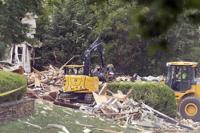FLAGSTAFF, Ariz. (AP) — A rapid spring snowmelt after an unusually wet winter is unleashing flooding from the Southwest to the Rockies, causing residents there and in the Upper Midwest to evacuate or stock up on sandbags amid surging creeks and rivers.
In New Mexico, emergency crews rescued people from at least two vehicles from high water Thursday night in Jemez Pueblo north of Albuquerque, the ��ɫtv Weather Service said.
But there were no immediate reports of any deaths of serious injuries. A flood warning was in effect for communities along the Jemez River into next week.
In Flagstaff, Arizona, neighbors on one street have been working side by side since Tuesday with shovels to stave off floodwaters from their homes.
Three creek-retention basins installed last year helped better navigate water that rushed down from burned mountains above the city, officials said. Still, water engulfed the shoulder of a local highway, and several roads and sidewalks were closed this week as the weather warmed and snow melted, making its way into neighborhoods. Sections of urban trails also were submerged.
Officials said it was a scenario that came without a playbook.
“It would be nice to have an exact model of what we need to do, but we don’t," Flagstaff Vice Mayor Austin Aslan told the "We don’t know what the next fire will look like, or where that scar will be. There’s small differences that will direct water to one neighborhood or another.”
Sandoval County in north-central New Mexico issued an emergency disaster declaration in the wake of severe flooding in communities near the Jemez River.
No evacuations had been ordered, but residents in an area between Jemez Pueblo and Jemez Springs that regularly floods in the summer rainy season were collecting sandbags as a precaution. A local police chief estimated a dozen homes and other structures along the river could be at risk of being inundated with water.
"Warm temperatures continue to cause rapid melting of snowpack, causing increased river flows," the ��ɫtv Weather Service in Albuquerque said Thursday night.
The deluge also led to spillover from a wastewater treatment plant, which was contributing recycled water into the Jemez River. The U.S. Forest Service advised people not to fish in the river or drink water south of the plant.
In Salt Lake City, Mayor Erin Mendenhall signed an emergency order late Wednesday aimed at helping residents whose homes were threatened by flooding in the southeastern part of the city. Rapidly melting snow in the nearby mountains sent water coursing through a creek in the neighborhood, prompting the voluntary evacuation of about 100 homes.
The water was receding as cooler weather moved into the area. Even so, multiple mudslides were reported on canyon roads, including one that forced the temporary closure of Interstate 80 southeast of the city early Thursday.
On Wednesday, local officials north of Salt Lake City issued evacuation orders for at least 20 homes in Kaysville, where flooding ripped a large gash that damaged a street, sidewalks and driveways in a subdivision that was under construction.
Meanwhile, heavy snowpack and highs expected to reach 60 degrees Thursday were causing flooding in northwest Colorado, where transportation officials closed Highway 40 between Craig and Steamboat Springs, a popular ski area that has received more than 400 inches (1,016 centimeters) of snow this winter.
Flooding in the small mountain town of Hayden forced schools to close. Rain was in the forecast Thursday afternoon, with the expectation of turning to snow overnight.
The Colorado Department of Transportation posted photos online showing Dry Creek spilling over its banks at a bridge there, as well as floodwater threatening several parked recreational vehicles.
The ��ɫtv Weather Service said some roads might become impassable during the weekend and urged motorists not to drive through flooded crossings.
There were no reports of major damage, however, in Utah or Colorado as of Thursday.
In the Northern Plains, a speedy snowmelt and possible April showers stoked fears of heavy flooding. Residents have been assembling thousands — if not hundreds of thousands — of sandbags to hold back water.
The Red River Valley, which includes Fargo in North Dakota and Moorhead in Minnesota, had one of the snowiest winters on record. Heavy rain could cause the river to rise quickly, Moorhead city engineer Bob Zimmerman told Minnesota Public Radio.
Minnesota’s Democratic Gov. Tim Walz said Thursday at a news conference that the state is ready to respond with financial help for flooding if needed.
He added that warmer temperatures and rising waters from climate change have factored into the state’s months-long preparation for the spring flooding season.
Local, state and federal public safety and emergency management partners have ramped up monitoring and preparation efforts, according to the state’s Department of Public Safety.
North Dakota Gov. Doug Burgum has declared a statewide emergency for spring flooding, and he made the ��ɫtv Guard available to help fight floods in the coming weeks, the Bismarck Tribune reported. The city of Bismarck opened sites for residents to fill their own sandbags.
In northern Montana, the Milk River was expected to rise to its highest level in more than a decade and swamp some rural areas.
Emergency officials along the river in Glasgow were patrolling the levee protecting the city of about 3,200 people to make sure it held up, said Valley County Disaster and Emergency Services coordinator Rick Seiler. Shelters were being arranged in case low-lying areas need evacuations.
The flooding was forecast to continue through next week, according to the ��ɫtv Weather Service.
Heavy rain was falling across the region on Thursday while snow continued to pile up at higher elevations, Seiler said.
___
Associated Press writers Trisha Ahmed in Minneapolis; Matthew Brown in Billings, Montana; Terry Tang in Phoenix; Thomas Peipert in Denver; and Scott Sonner in Reno, Nevada, contributed to this report.












































